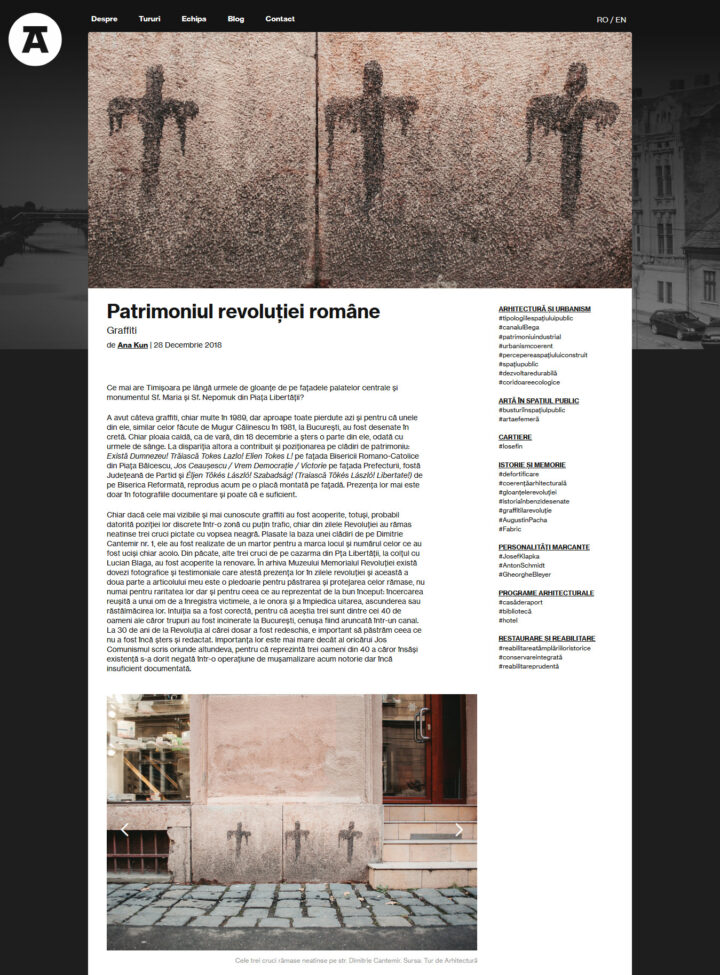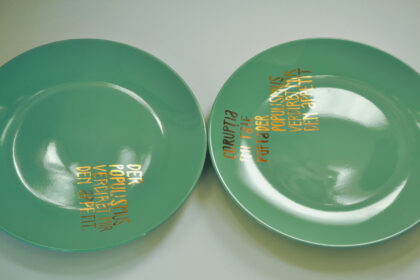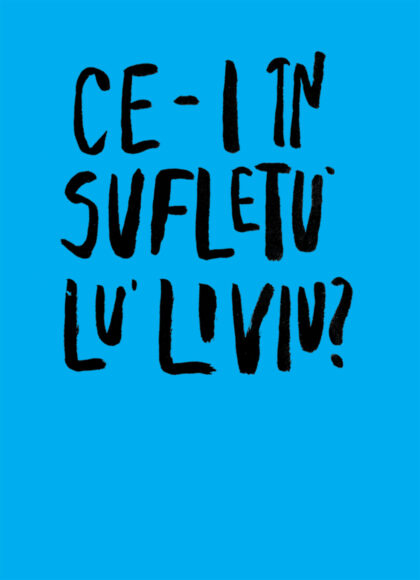La invitația Roxanei Pătrulescu de la Tur de Arhitectură, am scris un articol în două părți despre urmele Revoluției Române, o pledoarie (sau două) pentru conservarea lor ca parte a patrimoniului Timișoarei. Tur de Arhitectură este o echipă, un proiect și o platformă extraordinară în Timișoara, recomand cu căldură articolele și tururile lor.
Ce mai are Timișoara pe lângă urmele de gloanțe de pe fațadele palatelor centrale și monumentul Sf. Maria și Sf. Nepomuk din Piața Libertății?
A avut câteva graffiti, chiar multe în 1989, dar aproape toate pierdute azi și pentru că unele din ele, similar celor făcute de Mugur Călinescu în 1981, la București, au fost desenate în cretă. Chiar ploaia caldă, ca de vară, din 18 decembrie a șters o parte din ele, odată cu urmele de sânge. La dispariția altora a contribuit și poziționarea pe clădiri de patrimoniu: Există Dumnezeu! Trăiască Tokes Lazlo! Elien Tokes L! pe fațada Bisericii Romano-Catolice din Piața Bălcescu, Jos Ceaușescu / Vrem Democrație / Victorie pe fațada Prefecturii, fostă Județeană de Partid și Éljen Tőkés László! Szabadság! (Traiască Tőkés László! Libertate!) de pe Biserica Reformată, reprodus acum pe o placă montată pe fațadă. Prezența lor mai este doar în fotografiile documentare și poate că e suficient.
Chiar dacă cele mai vizibile și mai cunoscute graffiti au fost acoperite, totuși, probabil datorită poziției lor discrete într-o zonă cu puțin trafic, chiar din zilele Revoluției au rămas neatinse trei cruci pictate cu vopsea neagră. Plasate la baza unei clădiri de pe Dimitrie Cantemir nr. 1, ele au fost realizate de un martor pentru a marca locul și numărul celor ce au fost uciși chiar acolo. Din păcate, alte trei cruci de pe cazarma din Pța Libertății, la colțul cu Lucian Blaga, au fost acoperite la renovare. În arhiva Muzeului Memorialul Revoluției există dovezi fotografice și testimoniale care atestă prezența lor în zilele revoluției și această a doua parte a articolului meu este o pledoarie pentru păstrarea și protejarea celor rămase, nu numai pentru raritatea lor dar și pentru ceea ce au reprezentat de la bun început: încercarea reușită a unui om de a înregistra victimele, a le onora și a împiedica uitarea, ascunderea sau răstălmăcirea lor. Intuiția sa a fost corectă, pentru că aceștia trei sunt dintre cei 40 de oameni ale căror trupuri au fost incinerate la București, cenușa fiind aruncată într-un canal. La 30 de ani de la Revoluția al cărei dosar a fost redeschis, e important să păstrăm ceea ce nu a fost încă șters și redactat. Importanța lor este mai mare decât al oricărui Jos Comunismul scris oriunde altundeva, pentru că reprezintă trei oameni din 40 a căror însăși existență s-a dorit negată într-o operațiune de mușamalizare acum notorie dar încă insuficient documentată.
fragment din articolul Patrimoniul Revoluției Române, partea despre Graffiti

What has Timișoara besides the bullets on the façades of the central palaces and the monument of St. Mary and St. Nepomuk in Libertății Square?
It had a few graffiti, quite a lot in 1989, but almost all are lost today, mostly because some of them, similar to those made by Mugur Călinescu in 1981, in Bucharest, were drawn in chalk. Also the warm, summer-like rain of December the 18th washed some of them away, along with the traces of blood. To the disappearance of others their placement on patrimony buildings has also contributed: There is God! Long live Tokes Lazlo! Elien Tokes L! on the façade of the Roman Catholic Church in Bălcescu Square, Down with Ceaușescu / We want Democracy / Victory on the façade of the Prefecture, former Headquarters of the Communist Party, the County Branch and Long live Tőkés László! Freedom!, of the Reformed Church, now reproduced on a plate mounted on the façade. Their presence remains only in documentary photographs, and maybe that’s enough.
Even though the most visible and well-known graffiti were covered, however, probably because of their discrete position in an area with little traffic, three crosses painted with black paint remained untouched since the days of the Revolution. Placed at the base of a building on Dimitrie Cantemir Street at no. 1, they were made by an eye witness to mark the place and number of people who were killed right there. Unfortunately, three other crosses on the Libertății Square Barracks at the corner with Lucian Blaga were covered during the renovation. In the archives of the Revolution Memorial Museum there are photographic proof and testimonies that testify to their presence in the days of the revolution and this second part of my article is a plea to keep and protect the remaining ones, not only for their rarity but also for what they represented from the start: a successful attempt by a man to record the number of victims, honor them, and prevent their oblivion, concealment or misrepresentation. His intuition was correct, because these three are among the 40 people whose bodies were incinerated in Bucharest, the ashes thrown into a canal. 30 years after the Revolution, whose file has been reopened, it’s important to preserve that which has not yet been deleted or edited. Their significance is greater than any Down with the Communism written anywhere else, because they represent three people out of the 40 whose very existence was wanted denied in a now-familiar but still insufficiently documented shrouding operation.
excerpt from the English version of article The Patrimony of the Romanian Revolution, the part about Graffiti




